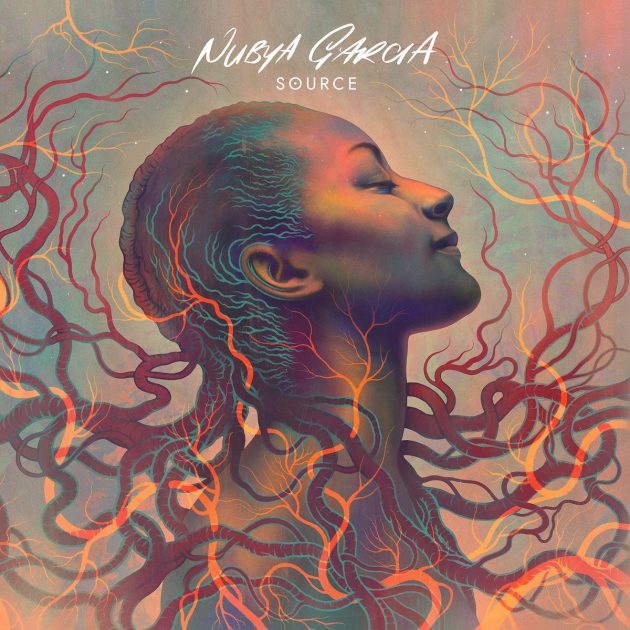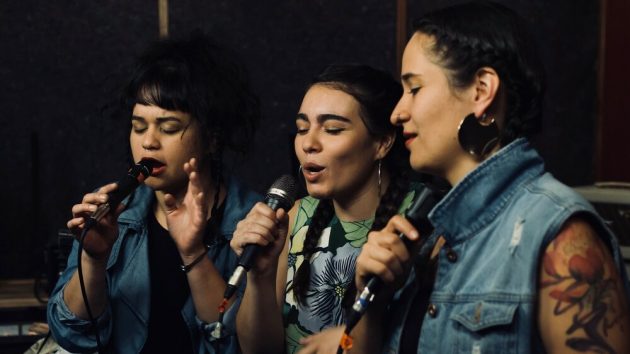
Nubya Garcia: The Big Picture
07 October, 2020An Interview & Conversation featuring La Perla’s Diana Sanmiguel
“It’s the difference between a painting the size of a whole wall with loads of different elements to it, and a wall with lots of different canvases on it.” Saxophonist and member of London’s celebrated jazz vanguard Nubya Garcia is explaining how she pictures her debut LP, Source, apropos of her acclaimed EPs, Nubya’s 5ive and When We Are… “My first offering was a collection of ideas. There wasn’t a clear story or narrative – there were a bunch of different ideas. This work just sounds different: it’s the whole story, the big picture.”
Garcia speaks lucidly about a project that, for someone who’s already won Jazz FM’s and Sky Arts’ “Breakthrough Act Of The Year” awards (2018) and Jazz FM’s “UK Jazz Act Of The Year” (2019), feels a long time coming. For her, Source (released on Concord Jazz, 21 August) was the culmination of an extensive vision. “I had a very clear picture beforehand of how I wanted everything to fit together, and of what it meant to me.” So, what did this picture look like?
“A collection of all the inspiration I’ve kept from childhood, the albums I always go back to, and the music I wanted to emulate: the compositional style of Wayne Shorter, the soundsystem nights in London, [Notting Hill] Carnival, and all the stories I’ve heard from my mum, dad and grandparents about where they’re from.” Dwelling on these stories, I ask Garcia what inspired the title of Source’s pulsating penultimate tune, “Before Us: In Demerara and Caura”.
“My mum was born in Demerara [in Guyana] and lived there until she was eighteen. I asked her so many questions: ‘What’s your first memories of where you grew up? What happened before us? Where were you before?’ My dad spent most of his summers going back to Trinidad [where his family is from] although he was born in England. Caura was the settlement where his father’s indigenous family originated. But the government forcefully moved them to make a dam – which was never even built in the end. They just moved everyone needlessly…
“[That track] is like an ode to how we were in our parents’ grandparents’ places before, even if we weren’t present… When you’re not from here,” Garcia continues, leaning into the “from here” somewhat sarcastically, “at some point in your life, you’re striving to learn more about your culture: maybe in a different life you would have been brought up elsewhere.”

Garcia’s “big picture” draws focus: Source’s overarching narrative is one of (re-)collection, (re-)connection – and of synthesis. “[The album] feels more connected than anything has before. That’s the purpose of an album – you’re bringing so much together into one sound-world.” On Source, a mosaic of dub, cumbia, and contemporary and trad. jazz, Garcia’s familial and musical heritages coexist alongside contemporary influences. Part of Source’s cohesive power can be attributed to the concluding song: a denouement, dexterously sung by Chicago polymath and prolific collaborator, Akenya. Speaking about narratives, I ask Garcia about this vocal mode of story-telling – something that’s altogether new for her.
“Working with vocals is always something I really wanted to do. They add another texture that I was really, really keen on. I was interested in adding backing vocals while I was singing [on saxophone], and making them meld together so they didn’t have to be upfront – like with Sheila [Maurice-Gray], Cassie [Kinoshi] and Richie [Seivwright on “Source” and “Stand With Each Other”].
“For [“Boundless Beings”], I wrote the melody and tune and then asked Akenya to lay vocals on it. We spoke about what the album meant to me and then she wrote lyrics that really summed up the whole album. It had to be at the end of the record – you listen to the whole album and then you hear lyrically exactly what you had heard in many other forms. The words fit with the idea of ‘connection’, ‘being rooted’… When she sings, “enter my dimension” – it’s an open invitation to be a part of this journey, sonically on the record. It brings people into the same community.”
For Garcia, a sense of community plays “a big part as one of those sources” to which her album’s title gestures.
For Garcia, a sense of community plays “a big part as one of those sources” to which her album’s title gestures. She explains: “the word source to me means a lot of things, but [here] I think it’s promoting the discussion of what drives someone… What makes them get up each day and give everything they can to what they chose – whether that’s their passion or their community.”
Source’s cover art embodies Garcia’s enthusiasm for connection and links notions of community to those of sources, or roots. In profile, eyes shut and head back, Garcia’s hair flows into what might either be tree roots or forked electricity. Through her braided hair – already a signifier for heritage – her body is connected to something greater; literally rooted, she gathers electric power. The North London saxophonist admits that these words – “source”, “community”, also “home” – have “taken on a very different meanings in this period of lockdown.

“I think it’s been amazing to re-establish how much home and community means – how important it is to be with people.” One such community for her is London’s jazz scene. “It’s been interesting and a really beautiful experience to realise how much importance I have placed on that… The simple experience of going to a gig and sharing in a space – on a different plane of hearing music; we can’t do that anymore. [Lockdown] places a higher value on these things that you think will always be there.”
London jazz is a community rooted in collaboration, both on record and at live sessions, such as legendary jams at Steez Café or Mau Mau Bar’s Jazz Re:freshed nights. Both events have now ended, and been succeeded by the likes of sessions at Deptford’s Matchstick Piehouse and social-distancing-friendly park jams run by “The Sesh Brehs” – the community still grows. Garcia speaks fondly of the scene she has often been made posterchild for. “Primarily, it’s just music. We’ve grown up together, we’re friends and family… And to me I’m just really proud of everyone – that everyone’s able to push themselves to create what they want to create. People are connecting over the music that my friends are making, my elders are making. I’m just here to make music, to write and play sessions with people that I am inspired by – and that’s always going to be at the crux of it. Everything else is bringing more people into the fold – and that’s a good thing.” Garcia concludes: “We’re not all here for ever and I think we need to be in the moment, really take joy in the experiences we can have with our community and learn within our community.”
A zest for knowledge underpins Garcia’s musical practices. And her desire to learn extends beyond studying her own heritage or home communities. Evinced by Source’s La Perla feature, “La Cumbia Me Está Llamando”, Garcia has a long-found love of Latin American music, culture and history. Indeed, the first time her and I met was DJing at my own Brazilian-music-only club night, Brazilian Wax, at which she pulled out a variety of rare, percussion-heavy tunes. I ask her where her this passion for Latin American music comes from.
“From family and heritage. I’ve always been fascinated in travelling to Guyana. My mum talks about what she learned at school, about the countries around her and also her own family… I’m really interested in learning more about Guyanese culture and the countries around it. But I’ve always loved Brazilian music of all kinds. When I went to Brazil for the first time, it was phenomenal – I found so much music. I was there just before Carnaval and there were so many blocos rehearsing. It was super inviting – I sat in with a bloco which was amazing…. Watching so many people in a place I’d never been playing music that I hadn’t really delved into, all at the top of their game…. It was truly inspiring and brought to so many different styles of music – cumbia, samba, salsa, everything.”
“The history is there, the teachings… The story-telling that they’d heard as kids, they’re telling in their own way now.“
She continues, returning again to community: “these musicians have been there for their whole lives – playing in the same place and people always come down, sit in… The history is there, the teachings… The story-telling that they’d heard as kids, they’re telling in their own way now. That community strength is incredible and we shouldn’t lose that. Some cultures place higher importance on that than others. Back home in the Caribbean, story-telling is a huge thing – as a kid in Trinidad, elder members of the community would literally feel all-seeing to me. They would pop out these wise words and I’d be like ‘bloody hell’.”
In a similarly inspirational trip, Garcia travelled to Colombia for the first time last year with British Arts Council, for a UK-Colombian collaborative project called MESTIZO involving Steam Down, Theon Cross and a number of Colombian musicians – including La Perla’s Diana Sanmiguel. It instigated an ongoing love affair with Colombian culture which culminated in Source‘s La Perla collaboration. Indeed, so enamoured was Garcia with Colombian culture, before even leaving the country for the first time, she’d planned to return to spend winter there. Animated, she speaks of that first trip:
“Bogotá was amazing – colder and a bit grey so it felt like home a bit. Luis [Gonzalez, MESTIZO general manager] was a telling us loads about the history of the city and how it’s got really fertile land – which is why it’s called Bogotá… The history of a lot of parts I need to revisit; it was fascinating. I spent four or five weeks in Medellín and had such an amazing time. It was full of music, full of fruit vendors!” She laughs, “I discovered so much fruit that I’d never seen before! It was amazing. I really love stuff like that – it really reminds me of the Caribbean.
“We also went to loads of museums – there’s a lot of history in that country… I’m just a student really. I’m interested in learning about the history and seeing how that influences where Colombia is now – and musically, how things have developed and where things originate from and why. I’m still at the beginning of this journey – it’s exciting.”
And how about the MESTIZO project itself? “That week was so, so influential. To meet so many musicians from all over Colombia in so many different disciplines – rappers, electronic musicians, percussionists, singers… It was really, really inspiring. I didn’t speak Spanish and some of them didn’t speak English but you still have this connection over music as another language – you don’t need to say any words, you just play. I never really think about how important that is. It’s incredible – really, really amazing how far you can connect with people via that medium and say so much.” Again, connection and community is at the crux.
Is there music from the collaboration? “I don’t know how much we’re allowed to say yet! We did do a whole day of recording – twenty-five people, switching drummers when needed playing in an old abandoned pasta factory. So there are some tunes…”
The MESTIZO sessions are already bearing fruit, though, in the form of Garcia’s collaboration with Sanmiguel’s band. I ask whether there was immediately a mutual admiration when the two met? “I thought she was such a phenomenal musician – what she can do with percussion and vocals is just insane! I can remember seeing her with maracas and thinking oh my gosh this is phenomenal. I’d never seen anyone play like that.”
By the time I sat down with Garcia, I’d already been emailing Sanmiguel about their collaboration. She was equally vociferous in her opinion of Garcia: “Nubya gave a concert in the park and I was enchanted by her music and her performance. I feel that since we met we’ve had a lot of affinity and mutual admiration. I remember that she was fascinated with Colombia, with the traditional instruments, the gaita, the marimba, the maracas, the songs… It was wonderful to see how she was seduced by all this – that she was living and feeling when collaborating with Colombian musicians.”
The two met again in London while La Perla were touring last October: “I’d been listening to her record since meeting her,” Garcia expounds, declaring La Perla’s London gig “phenomenal!
“I felt the energy. I knew they’d been on tour for a month and genuinely I know how hard that is to still have that much energy to give every single night. It’s a beautiful thing to witness – after I was like, ‘look, I really would love to collaborate with you, let’s just get into a studio and see what happens’. I’m totally inspired by what they do.”

Sanmiguel thinks back to that time… “Obviously, we accepted, we were delighted to play with such a powerful and expressive woman on her instrument. She returned to Colombia in December and we did an improvised session.
“We spent several days, then, playing, recording, partying, simply sharing… It was a great thing that she invited us to be a part of. But, actually, I would have liked to have shared more time with her. It was clear that she had a genuine empathy and taste for the music – for cumbia and other Colombian rhythms, too. She was studying Spanish, she made many friends, and clearly she was very attracted to the culture and music. The flow, the taste, the feeling, were all immediately captured by her playing – the connection when we played was immediate.”
I asked them both what they most identified with about each other’s music. “Probably the rhythms and drums and percussion,” Garcia immediately answers of the female percussion-led trio. “I just love that kind of driving rhythm! It propels you to dance – it’s very hard to stand still, it would feel weird. I think that [rhythm] is what draws you in.
“Also, I loved the way that they all sing, all play, all switch instruments… I really love that musicianship. And the way they’ve written their music and combined styles, you know. Sometimes they rap in their tunes, and I really loved their voices together.”
“In her sound, we heard diversity of styles and forms, which is also there with La Perla.“
Sanmiguel identifies versatility in both La Perla’s and Garcia’s music. “In her sound, we heard diversity of styles and forms, which is also there with La Perla. There is a malleability, Nubya offers both very strong and explosive moments, and other softer ones too… The versatility I think is our strongest connection, since our musical styles are very different but we could manage to communicate and create a wonderful piece.
“Also, the simple fact of being a female interpreter of an instrument as demanding as the saxophone at such a very high level, and with such a magic and a theatrical power makes us feel inspired.” I ask Garcia whether there’s an obvious, if slightly reductive link to make here… “I hadn’t really thought about it to be honest,” she laughs. “I never really do – I try not to base everything upon [my gender]. I just really like what they do because of their musicality.”
One thing they do share, though, is a mutual love for musical tradition: “with Nubya, although we never talked about the theme of the song before playing, it flowed naturally.” Sanmiguel suggests this is due to Garcia’s “interest in the roots.” Sanmiguel also gives her take on Garcia’s album title: “above all [“source” means, to me,] to have clarity and pride in who we are, where we come from, our identity, what we represent and what represents us. [La Perla] are very connected to traditional Colombian music, that is where our career in music started. It is important for us to continue creating innovative things but always to be clear about the influences, the roots, the legacy… The fact is that an essential part of our strength is following the relationship between music and memory.”
When asking Garcia about what she thought of modern Colombian music, she immediately makes a link to tradition. “I went to this really, really cool gig on the evening of the La Perla session. It was four producers in a square opposite each other in the middle of a club, with all the crowd just around them on the outside. [Each producer] had something else. It felt like they were bringing their traditional music through something else. Daniel [Michel] who works at Mambo Negro [, where the MESTIZO project was based,] played – he’s in the dub world in my opinion, but it was mixed in with traditional sounds. It was a really, really, really cool gig. It felt more modern.
“Obviously, when we got to Medellín, reggaeton was everywhere. We were staying in the party spot and it was blaring out of every single door – it was really cool, really amazing how much they love their music and that it’s rooted in culture and history and tradition and it’s their modern music.”
I think back to Garcia’s earlier opinion of Brazilian musical culture – “how the history is there”, how the stories heard as kids are now being retold a new way… Do you see yourself entering into a similar dialogue with a musical history and tradition?
“Probably not, but that is true – I do see it but I just don’t think about it. I don’t tend to think about [my music] in its wider place in the world because it just music at the end of the day.” She laughs. “It’s really enjoyable to write and play and I’m not devaluing it or doing any kind of self-deprecating; it is really based on real importance, and stories in my brain. But it’s just music and that’s all it has to be.” It might just be music, but Nubya Garcia’s debut is a statement of intent; a yoking together of countries and cultures, presented within a rich, comprehensive sound-world. It’s a full picture that, more than being the “size of a whole wall”, spans the whole world.
Source by Nubya Garcia is out now on Concord Jazz:
Follow Sounds and Colours: Facebook / Twitter / Instagram / Mixcloud / Soundcloud / Bandcamp
Subscribe to the Sounds and Colours Newsletter for regular updates, news and competitions bringing the best of Latin American culture direct to your Inbox.

